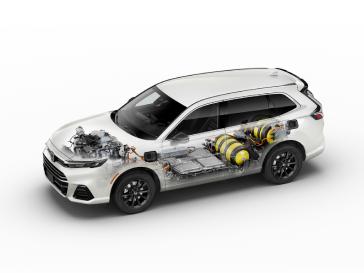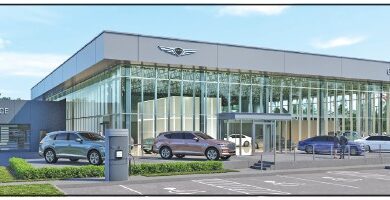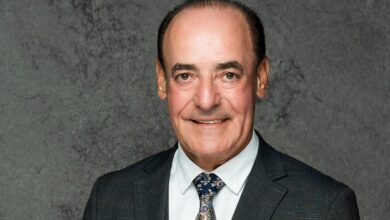Honda Reveals 2025 Honda CR-V e:FCEV – America’s First Production Plug-in Hydrogen Fuel Cell Electric Vehicle

- Advancing zero emissions mobility, the CR-V e:FCEV received a 270-mile EPA driving range rating while still delivering impressive power, cabin space and cargo capacity
- Combines all-new U.S.-made fuel cell system with plug-in charging capability to deliver EV driving around town and fast hydrogen refueling for longer trips
- CR-V e:FCEV is the only fuel cell electric passenger vehicle made in America1
- Battery-electric and fuel cell electric vehicles will represent 100% of Honda automobile sales by 2040
Honda today revealed America’s first production plug-in hydrogen fuel cell electric vehicle, the 2025 Honda CR-V e:FCEV. A fun-to-drive compact CUV that received a 270-mile EPA driving range rating, CR-V e:FCEV combines an all-new U.S.-made fuel cell system along with plug-in charging capability designed to provide up to 29 miles2 of EV driving around town with the flexibility of fast hydrogen refueling for longer trips.
“Leveraging Honda fuel cell technology expertise continues to play a critical role in our global goal to achieve carbon neutrality for all products and corporate activities by 2050,” said Mamadou Diallo, senior vice president of Auto Sales, American Honda Motor Co. “Honda has laid out an electrification strategy leading to 100% zero-emission automobile sales by 2040, including the introduction of both battery-electric and fuel cell electric vehicles like this new CR-V e:FCEV model.”
The 2025 Honda CR-V e:FCEV will be available for customer leasing in California beginning later this year.
Standard features include HondaLink® with expanded capabilities including hydrogen station information in addition to charging and power supply data. For additional convenience, the included Honda Power Supply Connector utilizes a 110-volt power outlet that can deliver up to 1,500 watts of power, turning CR-V e:FCEV into a clean power source capable of running small home appliances, portable air conditioners, power tools, camping equipment, and more.
Honda’s market experience with hydrogen fuel cell vehicles began with introduction of the Honda FCX in December 2002, the world’s first zero-emission fuel cell electric vehicle (FCEV) to receive certification for everyday use from both the U.S. Environmental Protection Agency (EPA) and the California Air Resources Board (CARB), as well as the first FCEV leased to individual customers.
The CR-V e:FCEV is built* at Honda’s Performance Manufacturing Center in Marysville, Ohio, and is the only fuel cell electric passenger vehicle made in America.
The 5-passenger CUV is the first application of the second-generation Honda Fuel Cell Module, which is produced at Fuel Cell System Manufacturing, LLC (FCSM) in Michigan, offering improved durability, higher efficiency, increased refinement and lower cost compared to Honda’s previous generation fuel cell system.
Co-developed with General Motors (GM), the next-generation Honda Fuel Cell Moduleleverages the knowledge, know-how and economies of scale of both companies and will reduce the cost by two-thirds compared to the cost of the fuel cell system in the Honda Clarity Fuel Cell. This significant cost reduction was achieved by various measures including the adoption of innovative materials for electrodes, advancement of a cell sealing structure, simplification of the supporting equipment and the improvement of productivity.
Moreover, the durability of the system has doubled by the application of corrosion-resistant materials and controlled suppression of deterioration, and low temperature performance was also improved significantly.
Key CR-V e:FCEV Standard Features:
- Distinctive bold and sophisticated styling
- All-new 2nd-generation Fuel Cell Module
- 270 mile zero-emission EPA driving range rating
- Plug-in Level II charging capability designed to provide up to 29 miles of battery electric range (EPA estimated)
- Sporty, modern, spacious and comfortable interior
- 10.2-inch digital instrumentation
- 9-inch HD touchscreen
- Wireless Apple CarPlay & Android Auto™ compatibility
- Wireless phone charging (Qi)
- Four selectable drive modes, including Snow and Sport
- Honda Sensing® system
Design and Technology
Distinctly styled from CR-V turbo and hybrid models, the sophisticated exterior design of the Honda CR-V e:FCEV stands out with new body panels forward of the A-pillar, unique designs for the liftgate, rear fascia and large 18-inch, 10-spoke black wheels.
Highlighting the refined new styling is an exclusive low upright grille design and long hood for an aggressively sleek look. The model’s signature vertical taillights make this zero-emissions variant instantly recognizable as a CR-V from the rear. To maximize driving range, aerodynamic performance has been further optimized with a full floor undercover and unique front spoiler and strake.
America’s best-selling CUV of the past quarter century, the Honda CR-V‘s spacious cabin features clean surfacing, high-quality feel of materials and top-class cabin space and cargo capacity. As in other CR-V models, a striking metal honeycomb mesh spanning the dash serves both form and function, concealing the air vents that would otherwise mar the uncluttered and harmonious design.
Honda will offer CR-V e:FCEV as a single, very well-equipped Touring model with standard features that include 10.2-inch digital instrumentation, 9-inch HD touchscreen, wireless Apple CarPlay and Android Auto™ compatibility2, wireless phone charging, a 12-speaker Bose premium audio system, power adjustable heated front seats, heated steering wheel, dual zone climate control, handsfree access power tailgate, parking sensors and sustainable materials including bio-based leather seat upholstery.
The 6th-generation CR-V is a leader in compact CUV safety features and performance and the new CR-V e:FCEV comes standard with the same cutting edge safety technologies as other CR-Vs, including Advanced Compatibility Engineering™ (ACE™) architecture and the Honda Sensing® suite of safety and driver-assistive technologies.
Sporty, Yet Comfortable Dynamics
The 2025 CR-V e:FCEV delivers a sporty, engaging and refined driving experience via a front-mounted single-motor producing 174 horsepower and 229 lb.-ft. of torque delivers quick acceleration and maximum efficiency.
Honda engineers have optimized the CR-V e:FCEV structure and suspension to deliver the same sporty driving experience and class-leading refinement as other CR-V models. Compared to CR-V turbo and hybrid models, rear lateral rigidity is increased 10%, rear torsional rigidity has improved 9% and its MacPherson strut front suspension and multilink rear suspension have been completely retuned with specific springs, amplitude-sensitive dampers and stabilizer bars front and rear to optimize responsiveness while maintaining a smooth ride.
CR-V e:FCEV qualifies for single-occupant California HOV lane access to reduce commute times and maximize quality of life. The driver can customize the driving experience with four selectable drive modes: Normal, Eco, Sport and Snow.
Triple Action to Zero Approach
Honda is working toward its global goal of zero environmental impact by 2050 through its “Triple Action to Zero” approach, including not only its products, but the entire product lifecycle including corporate activities.
- Carbon neutrality for all Honda products and corporate activities by 2050.
- Resource circulation using 100% sustainable materials to create a circular economy will enable Honda to recycle or reuse every bit of the materials from its vehicles, reprocess them back to raw materials and reuse those materials in the creation of new products. In short, to make new Honda vehicles out of old Honda vehicles.
- Clean Energy, including electrification and hydrogen for our company and all of our products in-use through renewable energy sources.
Honda Hydrogen Business
Working toward the realization of a carbon-neutral society, Honda will not only continue electrifying its products but also take a proactive approach to increase the use of hydrogen as an energy carrier and strive to expand its hydrogen business.
Honda has identified four core domains for the initial utilization of its new fuel cell system: FCEVs, commercial fuel cell vehicles, stationary power stations and construction machinery. While initial FCSM production will be used in support of Honda internal initiatives and FCEV sales, Honda is exploring external fuel cell business opportunities with a goal to begin external deliveries of the fuel cell system modules in the near future. The company envisions initial sales of 2,000 units per year and then expanding sales in stages.
Honda began demonstration testing of a stationary fuel cell power station on its Torrance, Calif. campus in March 2023, marking the company’s first step toward future commercialization of zero-emission backup power generation. The fuel cell power station supplies clean and quiet emergency backup power to Honda’s data center. In December 2023, Honda also announced a similar joint project in Japan where Honda will establish a stationary fuel cell station to power a Mitsubishi data center.
Backup power systems utilizing hydrogen fuel cells offer a promising future for clean, yet reliable and high-quality power generation, especially when operating on so-called “green hydrogen” made from renewable sources, with water vapor as the only emission.
Future stationary fuel cell (FC) units intended for commercialization will utilize the new Honda FC system. In the coming years, Honda will begin applying stationary FC power station technologies now under development – featuring a next-generation FC system with further cost reduction and improved performance – to Honda facilities and data centers globally.
In the area of commercial vehicles, the GIGA FUEL CELL, a zero-emissions fuel cell-powered heavy-duty truck currently being co-developed by Isuzu Motors Limited and Honda Motor Co., Ltd. was shown for the first time at the Japan Mobility Show 2023. In addition to conducting joint research on fuel cell heavy-duty trucks, the two companies have begun demonstration testing of a prototype model on public roads in Japan in December 2023, and plan to introduce the production model to market in 2027 by fully leveraging the technology, experience and knowledge gained through the joint research.
Moreover, Honda is preparing a proof-of-concept Class 8 hydrogen fuel cell truck in the U.S. and is in talks with potential customers.
Honda also will take initiative to apply its fuel cell system to construction equipment such as excavators and wheel loaders, contributing to the realization of carbon neutrality for construction machinery.
Honda is conducting advanced research and development of hydrogen technologies while envisioning use in outer space, another potential area where hydrogen technologies such as a fuel cell system and high differential pressure water electrolysis technologies can be utilized. In addition to water and food, people need oxygen, as well as hydrogen for fuel and electricity for various activities supporting life in space.
For more information on Honda’s hydrogen business initiatives click here. Companies interested in the new Honda fuel cell system and hydrogen business partnerships may contact hydrogen@na.honda.com.
2025 Honda CR-V e:FCEV Key Specifications and Features
|
ENGINEERING
|
|||
|---|---|---|---|
|
Estimated Power Output
|
92.2kW
|
||
|
ENGINEERING
|
|||
|
Peak Horsepower
|
174 hp
|
||
|
Peak Torque
|
229 lb.-ft.
|
||
|
BATTERY
|
|||
|
Capacity
|
17.7 kWh
|
||
| FUEL | |||
|
MPGe Ratings (City / Hwy / Combined)
|
61 / 52 / 57
|
||
|
EV Range (miles)
|
29
|
||
|
Driving Range (miles)
|
270
|
||
| Required Fuel | Compressed Hydrogen Gas | ||
|
Fuel Tank Pressure
|
10,000 psi
|
||
|
Fuel Tank Capacity (kg)
|
4.3
|
||
|
WHEELS AND TIRES
|
|||
|
Wheel Size
|
18-inch
|
||
|
Tire Size
|
235/60R18
|
||
|
EXTERIOR MEASUREMENTS
|
|||
|
Wheelbase (in.)
|
106.3
|
||
|
Length (in.)
|
187.6
|
||
|
Height (in.)
|
66.6
|
||
|
Width (in.)
|
73.4
|
||
|
Track (in., front/rear)
|
63.4 / 64.0
|
||
|
KEY FEATURES
|
|||
|
Honda Sensing®
|
•
|
||
|
Advanced Compatibility Engineering™ (ACE™) Body Structure
|
•
|
||
|
10.3-inch Digital Instrument Display
|
•
|
||
|
9-Inch HD Touchscreen
|
•
|
||
|
Wireless Apple CarPlay®, Android Auto™ Compatibility
|
•
|
||
|
Heated Front Seats
|
•
|
||
|
Heated Steering Wheel
|
•
|
||
|
Wireless Phone Charging (Qi)
|
•
|
||
|
Bose Premium Audio (12-speaker)
|
•
|
||
|
Driving Modes
|
Normal, Eco, Sport, Snow
|
||
About Honda
Honda offers a full line of clean, safe, fun and connected vehicles sold through more than 1,000 independent U.S. Honda dealers. The award-winning Honda lineup includes the Civic and Accord, along with the HR-V, CR-V, Passport and Pilot sport utility vehicles, the Ridgeline pickup and the Odyssey minivan. Honda’s electrified vehicle lineup includes the Accord hybrid, CR-V hybrid, and later this year, Civic hybrid. The Honda Prologue SUV, Honda’s first volume battery-electric vehicle, will also join the lineup this March.
Honda has been producing automobiles in America for over 40 years and currently operates 18 major manufacturing facilities in North America. In 2023, more than 99% of all Honda vehicles sold in the U.S. were made in North America, with around two-thirds made in America, using domestic and globally sourced parts.
More information about Honda is available in the Digital FactBook.
# # #
1. Using domestic and globally sourced parts
2. EPA-estimated 29-mile all-electric driving range when fully charged. Use for comparison purposes only. Actual range will vary based on several factors, including temperature, terrain, battery age & condition, loading, use and maintenance.



